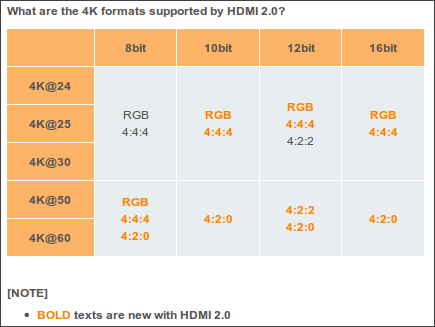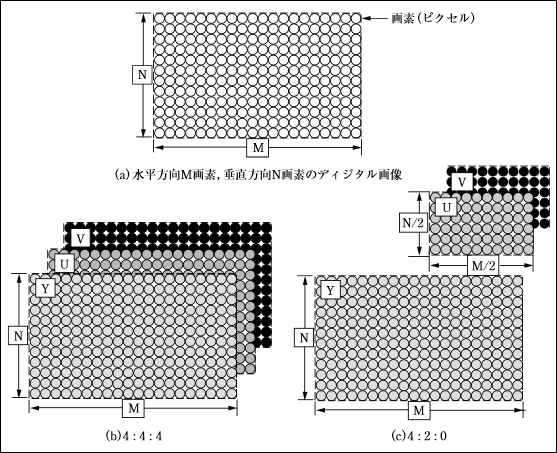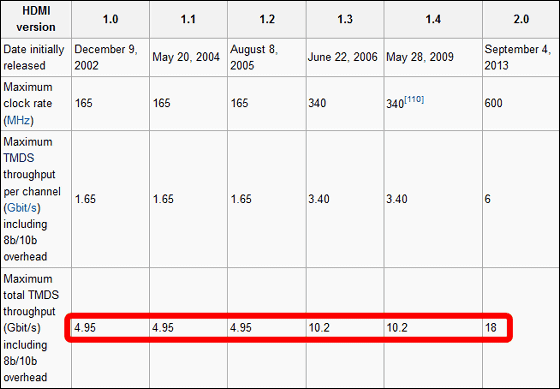How is the HDMI 2.0 standard fulfilling full-scale response to 4K contents evolving?

It has 4 times the resolution of full HD (1920 × 1080)4K resolutionHas attracted much attention because it is also used in next-generation television broadcasting. In order to cope with the transmission of the 4K contentsHDMIVersion 2.0 (HDMI 2.0) appeared in the standard, but I will represent Sykhronics Entertainment, a game production company, on how we evolved compared to the previous HDMI 1.4Mike KasprzakMr. Blog explains it.
4k, HDMI, and Deep Color «tooNormal
http://www.toonormal.com/2014/01/10/4k-hdmi-and-deep-color/
At the moment TVs compatible with HDMI 2.0 are not on sale, but at the venue of CES 2014Corresponding 4K televisionThere were some exhibits. It is generally said that "It corresponds to 4K contents by HDMI 2.0", but this expression by Kasprzak is not accurate. Regardless of the conventional HDMI 1.4, reproduction of 4K contents is possible depending on the conditions, and because there are many conditions that can not be played back even with HDMI 2.0.
This table shows the difference in response to 4K contents in the version upgrade from HDMI 1.4 to HDMI 2.0. Black letters support even with HDMI 1.4, Orange represents newly corresponded images by HDMI 2.0.

In order to understand this table, we will briefly explain the meaning of terms in the table.
◆bit
"Bit" at the top of the table represents the maximum number of colors that can be displayed by the pixels making up the digital image / video. Since one frame of video is displayed by combining three images, for example, 8 bits × 3 = 8 bits for RGB · 8 bits =24 bits(About 16.78 million) colors can be expressed.
◆frame rate
The numerical part of "4K @ (number)" on the left of the table isframe rateIt shows. The frame rate is the value of how many frames can be processed per second. The higher the number, the smoother the image and the better the quality.
◆RGB
RGBShows a method of reproducing images by mixing the three primary colors of red (R), green (G), and blue (B).
◆YCbCr (YUV)
Three numeric notation in the table, such as "4: 4: 4"YCbCr (YUV)This is a method of reproducing colors with numerical values converted based on values expressed in RGB, which is called "
In YUV, images are expressed as sets of three types of images: luminance (Y) and color difference (U and V). Among YUV, images that do not drop any resolution are written as "4: 4: 4". In YUV, 4: 4: 4 is the highest quality image and can be said to be a high quality image.
On the other hand, the thinned out pixels are "4: 2: 2" and "4: 2: 0" for the purpose of reducing the information amount of the digital image. Since human's visual characteristics are less sensitive to color than sensitivity to luminance, it is preferable to thin out the image of the color difference (U and V) without thinning out the image of the luminance (Y), thereby suppressing deterioration of image quality It is possible to reduce the amount. "4: 2: 2", thinning out each of the U and V images in half in the horizontal direction and thinning out both horizontal and vertical directions in half are expressed as "4: 2: 0".
The Institute of Image Information and Television EngineersPDF file published by "Keywords you want to know 4: 4: 4 and 4: 2: 0An easy-to-understand figure is posted on the website.

Based on the above terminology, looking at the table above again, in HDMI 1.4, the frame rate is 24: 4: 2: 4, 12 bits 4: 2: 2 of 8 bits RGB · 8 bits It corresponds only to 4K video of ~ 30, while HDMI 2.0 compatible with more 4K video.

Kasprzak notes that HDMI 2.0 is compatible with "4: 2: 0 video at 60 frame rate" among others. Since most of Blu-ray movies are encoded at 4: 2: 0, HDMI 2.0 is required to output 4K Blu-ray movies at high image quality.
However, Mr. Kasprzak thinks that it is not enough for HDMI 2.0 to obtain high quality 4K video. The cause is due to the narrowness of the bandwidth of the HDMI standard. For example, the bandwidth of 4 K video with 8 bit color · 60 frame rate can reach 12 Gb / s at the maximum and 18 Gb / s at 12 Kbit · 60 frame rate maximum for 4 K video, so it can handle up to 18 Gb / s band Even HDMI 2.0 which has done it is already in a state where there is not enough bandwidth.

Especially, it is a game using a high-spec PC that is more problematic than movies such as TV and Blu-ray. In order to satisfy a gamer wishing to play at a high frame rate in a 4K resolution game, it seems indispensable to emerge the HDMI standard which further advanced HDMI 2.0.
Related Posts:







